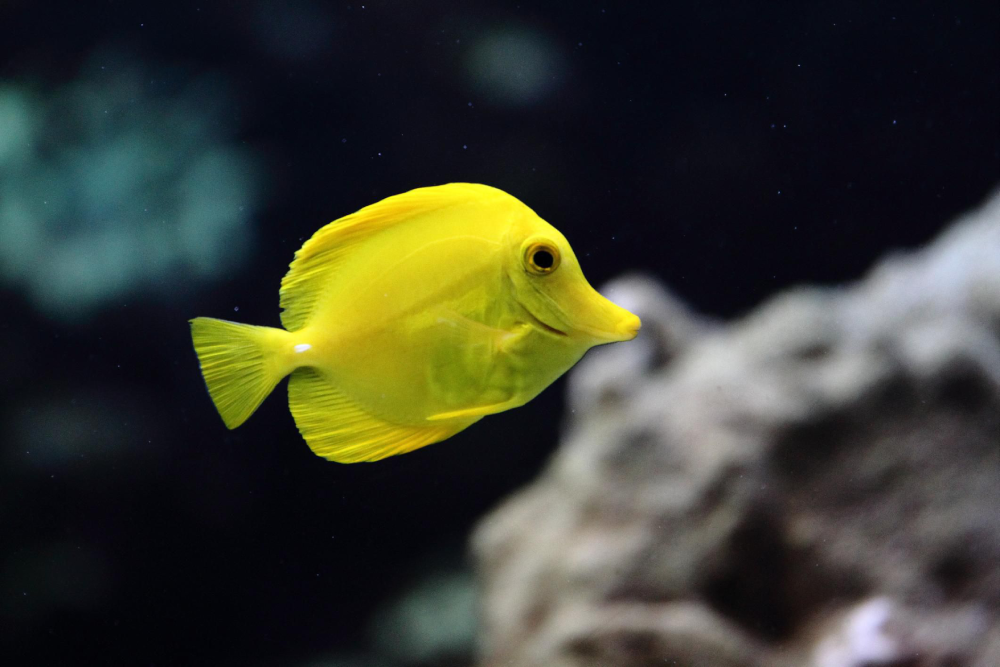Introduction to the Yellow Tang
Scientifically known as Zebrasoma flavescens, the yellow tang is a member of the surgeonfish family Acanthuridae. Endemic to the waters of the Indo-Pacific region, these enchanting creatures commonly live in the coral reefs of Hawaii, where they roam among the intricate formations of living polyps and vibrant marine life. Their striking yellow coloration, accented by delicate blue highlights, distinguishes them as one of the most recognizable inhabitants of these tropical waters.

Anatomy and Physiology
Yellow tangs boast a streamlined body adorned with a single, continuous dorsal fin and a distinctive spine near their tail, characteristic of surgeonfish species. Their vibrant yellow coloration serves as more than just an aesthetic feature; it also serves as a form of camouflage among the sun-dappled coral reefs, providing them with protection from predators and allowing them to blend seamlessly into their surroundings.
Habitat and Distribution
The natural habitat of the yellow tang encompasses the shallow, clear waters of coral reef environments, where they can be found grazing on algae and seeking refuge among the nooks and crannies of the reef structure. While they are most commonly associated with the Hawaiian Islands, yellow tangs also inhabit other regions of the Indo-Pacific, including the waters around Japan, Indonesia, and the Philippines.
Diet and Feeding Behavior
Yellow tangs are primarily herbivorous, feeding on a diet consisting mainly of algae and other plant matter. Their specialized mouths, equipped with tiny teeth designed for scraping algae off rocks and coral, allow them to efficiently graze on surfaces within their environment. This feeding behavior not only sustains the yellow tang population but also plays a crucial role in maintaining the delicate balance of coral reef ecosystems by controlling algal growth.
Social Structure and Behavior
In their natural habitat, yellow tangs are often encountered in small groups or schools, where they engage in various social interactions such as foraging for food, navigating through their environment, and establishing dominance hierarchies. Despite occasional territorial disputes, these fish generally exhibit peaceful behavior towards one another, forming intricate social networks within their coral reef communities.
Reproduction and Life Cycle
The reproductive cycle of the yellow tang is a fascinating process that begins with courtship rituals conducted by mature individuals. During these displays, males showcase their vibrant colors and engage in elaborate dances to attract potential mates. Once a pair has formed, they release their eggs and sperm into the water, where fertilization occurs externally. The fertilized eggs then develop into larvae, which drift in the ocean currents before settling back onto the reef as juveniles, where they begin their transformation into adult yellow tangs.
Conservation Status and Threats
Despite their widespread distribution and relative abundance in certain areas, yellow tangs face a range of threats that jeopardize their long-term survival. Overfishing, habitat destruction, and the impacts of climate change, including coral bleaching events and ocean acidification, pose significant challenges to yellow tang populations and the coral reef ecosystems they inhabit. Efforts to conserve and protect these vital habitats are essential for ensuring the continued existence of this iconic species and the countless other organisms that rely on healthy coral reefs for their survival.
Conclusion
In the intricate tapestry of life that thrives beneath the waves, the yellow tang shines as a radiant symbol of the beauty and diversity of coral reef ecosystems. From its vibrant coloration to its vital role in maintaining the balance of these fragile habitats, this remarkable fish captivates the imagination and inspires awe in all who encounter it. As stewards of the ocean, it is our responsibility to safeguard the future of the yellow tang and the wondrous underwater worlds it inhabits, ensuring that future generations may continue to marvel at its splendor for years to come.









